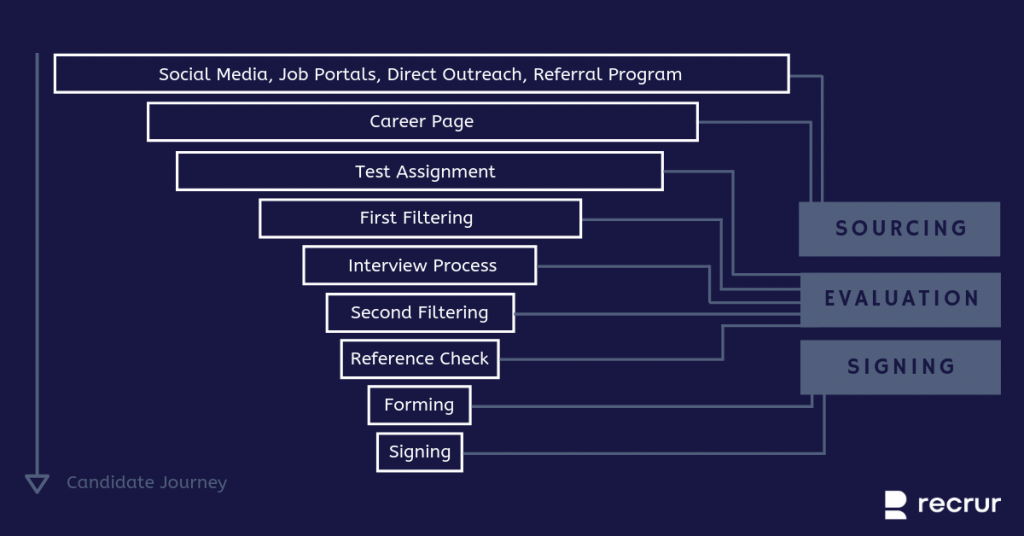Spoiler: You don’t need to be a programmer or a scientist to measure your recruitment efforts effectively – you don’t even need to be good at math.
What is a recruitment funnel?
A recruitment funnel is a set of steps your candidate goes through in order to get hired. It’s called a funnel because at the beginning of the process, there are a lot of people who take the first step. At each following, step candidates will drop out or get filtered out. As the size of the crowd narrows, you will end up with a much smaller selection of people than you started out with. This is both a natural and necessary process in order for you to make the best hiring decision. When measured next to each other the steps will form a funnel-like shape.
Building your recruitment funnel.
No matter your industry or company, your recruitment funnel should boil down to the following three core processes. Candidate Sourcing > Candidate Evaluation > Signing

Candidate Sourcing…is a process of finding candidates and creating a list of potential people who you can choose from in order to fill an open position.
A few samples of how you can Source candidates are: direct email reach out, creating the position on a local job portal, networking in related events, advertising the open position on social media, advertising the position on your career page, finding and contacting potential candidates by phone or via LinkedIn.
Candidate Evaluation…is the process of hand-picking and testing the best fitting individuals from your list of candidates. The evaluation process is usually a combination of the following activities: Testing if the candidate has the necessary skill set required to fill the job, checking the candidate references, checking if the candidate will fit the company culture and if the candidate shares similar values to the employer. These questions are often answered by meeting the candidate face to face, via Skype or phone call and by having a discussion internally with invested parties.
Candidate Signing…is usually the last part of the hiring process where an offer is discussed and (hopefully) agreed upon. These things usually are: specific employee expectations, employee salary, resources that are being made available to fill job expectations, employee benefits, adherence to the company culture and whatever else is deemed necessary. The signing process usually concludes with signing a written contract and locking in the final details of employment.
What do you measure in recruitment?
Each step should be measured independently in order to find and fix bottlenecks in the recruitment process. The goal of each step is to drive as much relevant traffic as possible to the next step. For example if you’re using social media for recruitment, then it’s sensible to measure the amount of leads your social media activities are generating and how many of those leads make it to the next step. In that example you’re measuring both the Quality and Quantity of the leads generated from social media.
When you are inviting your candidates to an interview your measurement metrics should be similar. Did the candidates meet the par set for employment? And how many of them did so? The more great quality candidates you have to choose from, the better. If there are too many unqualified candidates, then there is an error in one of your previous steps.
Analyzing the effectiveness of your recruitment.
Outside of the recruitment teams most people will only care about the “input vs output” ratio. When it comes to the business management, recruitment needs to answer the following questions:
- How quickly can you fill a specific opening?
- How much will it cost to fill that opening?
In a perfect world you want to achieve the maximum effect with minimum resource spend.
In reality it’s important to understand that different positions will present different challenges for recruitment. Filling a Fruit Picker role for a farm is completely different than filling a AI Developer role for a bank. Each role brings different set of challenges and market dynamics when it comes to hiring. But an experienced recruiter will be able to offer you a rough estimate.
How many resources should you invest into hiring?
Throwing money at a problem is not always the solution and you should always try to utilize the resources you already have available. The costs can vary massively depending on what kind of role you’re looking to fill. We’ve tried to put rough estimate on how much different activities can end up costing you:
Building a career page?
Why not allocate two days of your designer’s time to create a page mock-up and one extra day for iterations. After that you should schedule about 3 days of front-end developer’s time. The time it takes to build that page varies depending on the complexity of the page and competence of your team. Outsourcing said page development ranges usually between 400 EUR to 6000 EUR depending on the quality, speed and amount custom developments.
Going to a career event?
These events usually cost between 125 EUR to 275 EUR per person. Also worth mentioning are the accommodation costs on top of that, if the event takes place outside of your own city or country.
Job Board fees.
Want to advertise your job opening on the local Job Portal? Posting there can cost you anywhere starting from 240 EUR to 760 EUR per posting on average. We included LinkedIn in here as well.
Internal HR team costs.
The general estimates for maintaining one HR member on your payroll land anywhere between 85k to 120k EUR a year for the company.
The cost of onboarding new members.
Depending on the role it can take up to 8 to 26 weeks before a new employee reaches full productivity. Onboarding process tends to be faster for low end positions and takes longer for high end managerial positions. This means that during the onboarding period your company is still bleeding money.
What will be the total cost?
Depending on the position you should estimate that the total cost of onboarding a new member is roughty the 3x cost of their monthly salary. Once that person is hired, then you will also start paying them a running monthly salary on top of that.
Overcome analysis paralysis.
In the end you may not care about going into that much detail. It’s a lot of work gathering the numbers and keeping your eye on everything. Your goal should be to hire great people and do so efficiently and with optimal resource spend. We built Recrur to help you with all that. We provide you with easy access to statistics and help you structure your funnel so it makes your life easier and more comfortable.

WRITTEN BY
Mihkel Stint
Marketing manager in Recrur. Mihkel helps the recruitment team implement their social media efforts. He is also responsible for communications in addition to his marketing duties.





